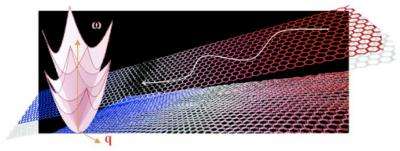Sound could save circuits: Researchers theorize acoustic waves may cool microelectronics

(PhysOrg.com) -- "Hot sounds" has one meaning to music fans and another to physicists. Count a team of researchers at Rice University among the latter, as they've discovered that acoustic waves traveling along ribbons of graphene might be just the ticket for removing heat from very tiny electronic devices.
A theoretical model by Rice physicist Boris Yakobson and his students has determined graphene - a single-layer honeycomb of carbon atoms and the focus of much materials science and electronics research - can transmit thermal energy in waves. Given the elastic properties of graphene, long waves of the acoustic kind seem to work best. Because the scattering properties of graphene are low, such waves can go fast and far, unobstructed by each other or by imperfections in the material.
You'd never hear anything, no matter how close you put your ear to the nanoscale ribbon, Yakobson said. But to the researchers, the implications are clear as a bell.
"On this scale, graphene has promise for fundamental reasons," said Yakobson, a Rice professor in mechanical engineering and materials science and of chemistry and part of a program recently named No. 1 in the world for the quality of its materials science research. "The speed of sound is the speed with which energy can be carried away, because heat is transported, essentially, through vibrations."
Yakobson and his co-authors, former postdoctoral associate Enrique Muñoz, now an assistant professor in the Department of Mathematics and Physics at the University of Playa Ancha in Chile, and Jianxin Lu, a Rice graduate student, published their results last week in the online edition of the journal Nano Letters.
Muñoz, the paper's primary author, said the "nearly ballistic behavior" of phonons, quantum particles considered sound's equivalent to light's photons, makes the graphene material 10 times better than copper or gold at conducting heat.
The trick to making such graphene-enabled heat pipes effective will be to figure out where the heat goes when it gets to the end of the ribbon, an issue Lu continues to study for both nanoribbons and nanotubes. Without an effective interface, the propagating waves of phonons would simply bounce back.
"You need another medium," Yakobson said. "That's why I say this is more of a heat pipe than a heat sink, because at the far end of the graphene, you need contact with fluid, in a gas or liquid phase, so this wave energy can dissipate."
The power density of current microelectronics would, on a macro scale, be enough to heat a teapot to boiling in seconds. So it's becoming increasingly important to remove heat from sensitive instruments and release it to the air in a hurry.
"We're dealing with a very high heat density - maybe a kilowatt per centimeter square," Yakobson said. "When you want to barbecue, such heat is very useful. But in this case, you'd basically barbecue your device."
Finding a way to deal with transmitting heat away from ever-smaller devices is critical to sustaining Moore's Law, which accurately predicted (so far) that the number of transistors that could be placed on an integrated circuit would double about every two years.
"Another interesting application of these ribbons is in the construction of phonon waveguides," Muñoz added. "Graphene ribbons could be pieces in a nanoscale circuit where phonons, instead of electrons, serve as information carriers in a different computer architecture."
More information: Read the abstract here: pubs.acs.org/doi/abs/10.1021/nl904206d
Provided by Rice University





















